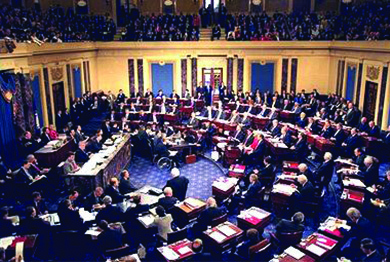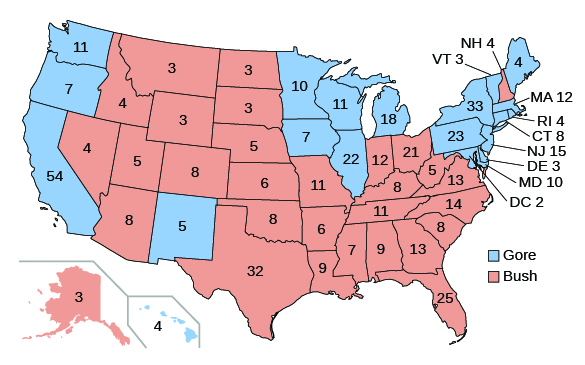| << Chapter < Page | Chapter >> Page > |

Despite Clinton’s high approval rating, his vice president and the 2000 Democratic nominee for president, Al Gore, was eager to distance himself from scandal. Unfortunately, he also alienated Clinton loyalists and lost some of the benefit of Clinton’s genuine popularity. Gore’s desire to emphasize his concern for morality led him to select Connecticut senator Joseph I. Lieberman as his running mate. Lieberman had been quick to denounce Clinton’s relationship with Monica Lewinsky. Consumer advocate Ralph Nader ran as the candidate of the Green Party , a party devoted to environmental issues and grassroots activism, and Democrats feared that he would attract votes that Gore might otherwise win.
On the Republican side, where strategists promised to “restore honor and dignity” to the White House, voters were divided between George W. Bush, governor of Texas and eldest son of former president Bush, and John McCain, an Arizona senator and Vietnam War veteran. Bush had the robust support of both the Christian Right and the Republican leadership. His campaign amassed large donations that it used to defeat McCain, himself an outspoken critic of the influence of money in politics. The nomination secured, Bush selected Dick Cheney, part of the Nixon and Ford administrations and secretary of defense under George H. W. Bush, as his running mate.
One hundred million votes were cast in the 2000 election, and Gore topped Bush in the popular vote by 540,000 ballots, or 0.5 percent. The race was so close that news reports declared each candidate the winner at various times during the evening. It all came down to Florida, where early returns called the election in Bush’s favor by a mere 527 of 5,825,000 votes. Whoever won Florida would get the state’s twenty-five electoral votes and secure the presidency ( [link] ).

Because there seemed to be irregularities in four counties traditionally dominated by Democrats, especially in largely African American precincts, Gore called for a recount of the ballots by hand. Florida’s secretary of state, Katherine Harris, set a deadline for the new vote tallies to be submitted, a deadline the counties could not meet. When the Democrats requested an extension, the Florida Supreme Court granted it, but Harris refused to accept the new tallies unless the counties could explain why they had not met the original deadline. When the explanations were submitted, they were rejected. Gore then asked the Florida Supreme Court for an injunction that would prevent Harris from declaring a winner until the recount was finished. On November 26, Harris declared Bush the winner in Florida. Gore protested that not all votes had been recounted by hand. When the Florida Supreme Court ordered the recount to continue, the Republicans appealed to the U.S. Supreme Court, which decided 5–4 to stop the recount. Bush received Florida’s electoral votes and, with a total of 271 votes in the Electoral College to Gore’s 266, became the forty-third president of the United States.
Bill Clinton’s presidency and efforts at remaking the Democratic Party reflect the long-term effects of the Reagan Revolution that preceded him. Reagan benefited from a resurgent conservatism that moved the American political spectrum several degrees to the right. Clinton managed to remake the Democratic Party in ways that effectively institutionalized some of the major tenets of the so-called Reagan Revolution. A “New Democrat,” he moved the party significantly to the moderate center and supported the Republican call for law and order, and welfare reform—all while maintaining traditional Democratic commitments to minorities, women, and the disadvantaged, and using the government to stimulate economic growth. Nevertheless, Clinton’s legacy was undermined by the shift in the control of Congress to the Republican Party and the loss by his vice president Al Gore in the 2000 presidential election.

Notification Switch
Would you like to follow the 'U.s. history' conversation and receive update notifications?